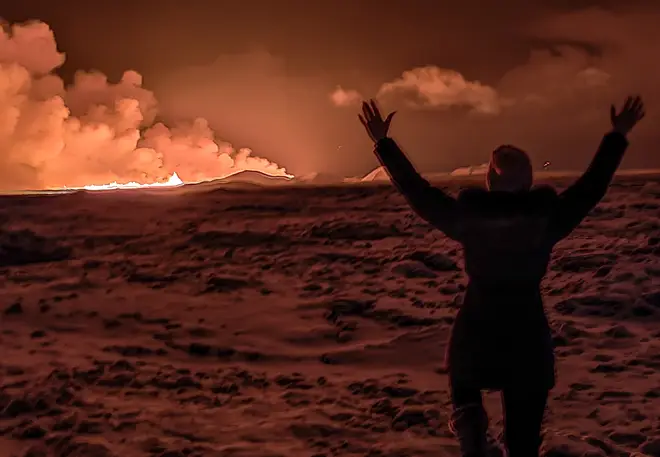
Richard Spurr 1am - 4am
19 December 2023, 18:47 | Updated: 19 December 2023, 18:50

Volcano erupts in Iceland weeks after thousands evacuated from town
Gas pollution is "likely" to occur in the Icelandic capital after it was hit by a huge volcanic eruption last night.
A warning was put out by the Icelandic Meteorological Office this afternoon, as the volcanic eruption's intensity decreases.
The volcano eventually erupted late on Monday evening after weeks of intense earthquake activity.
Thousands of residents were evacuated from their homes due to the looming threat, including the fishing town Grindavik, but adrenaline junkies defied warnings from Icelandic authorities this morning.

They had been warned to stay away from a volcano after it dramatically erupted overnight.
Stark pictures show crowds of people taking photos as an orange glow lights up the night sky and molten rock spews from the ground.
One image showed a queue of traffic heading towards the area despite police telling people to do the exact opposite.
The eruption took place on Hagafell, in Iceland's southwestern Reykjanes peninsula, on Monday night.
Read more: Volcano erupts in Iceland after weeks of intense earthquake activity as thousands evacuated

Grindavik
Almost 4,000 people in nearby Grindavik, a fishing town, had been evacuated in anticipation of the activity, while a popular spa called Blue Lagoon was shut down.
A raft of earthquakes preceded the eruption, including the more than 230 recorded close to Grindavik overnight on Sunday.
But despite the danger, crowds of people descended on the peninsula to take in the sight - prompting officials to intervene as the civil defence was placed on high alert.


"Think about someone other than yourself and follow the guidelines of the public safety. Please," said an environment ministry spokesperson.
Iceland's police said: "An eruption has begun. We ask people not to be in front of the responders and not to go in the direction of the eruption.
"It is important that roads and other things are as accessible as possible."
Iceland's president, Guðni Thorlacius Jóhannesson, said: "It is not clear what damage it can cause, but now we rely on our scientists as well as all those who need to do monitoring and other operations.

"Above all else, we protect human life but we do all the defence of structures to the best of our ability. I send warm greetings to the people of Grindavik and those who now work on the scene."
A flash of light was recorded on webcam footage at about 10.17pm local time.
Magma was later seen spewing down the ridge of hill. Vidir Reynisson, Iceland's civil protection boss, said it was flowing at "at least a hundred cubic metres per second, maybe more".

"So this would be considered a big eruption in this area at least," he added.
A coast guard helicopter will assess the impact of the eruption.
The eruption will conjure memories of the Eyjafjallajökull eruption in 2010, which caused widespread disruption to European air travel.
This time, however, Reykjavik's airport remained open, despite the capital being just 25 miles to the northeast.